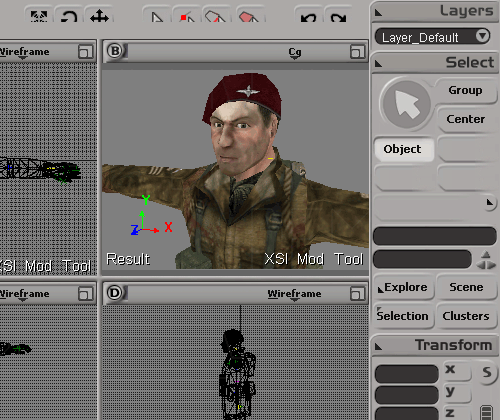


Instead of like 3D Studio Max and Lightwave, Softimage keeps everything in a scene stored in a large database (a fancy name for "a bunch of folders in another folder that hold files"). Softimage has an interesting way of managing scenes. That's just a light overview of the modules, each one in the box has what amounts to it's own book (of varying thickness). Also included are tools for processing finished scenes( MakeMovie+) that allows you to produce compressed video. Here are basic proofing tools, such as a flipbook that allows you to preview an animation from the freshly rendered scene, model processing tools that can prep properly built models for use on a nintendo64, playstation, or even sega saturn (replaced now). Also are the ability to create bounded objects, apply gravity and other deformation effects, such as warps and detonations. Basic features of this module are the ability to create skeletons, apply skins, and weight points. The Extreme package comes with the default SI Scanline renderer, and the Mental Ray raytracer (which the softimage UI caters to).Īctor is where physics and bones/ structure come into play. It offers various renderer choices, depending on your version of Softimage. Incidentally, rendering is handled in the matter module. By then moving the object you've textured slowly, you get a nice stream. By applying the script as a bump map, you can get quite realistic rippling water. But when brought in as a 2D texture, accompanied by a script, it can be animated. In the resulting 2d rendering, it looks like rings expanding in and out, and warping. By rendering some of this on a flat surface, you can get a nice animation of dots moving in and out. A good example of this is that a 3D texture can move in the Z axis, giving you an effect of rippling water. It exists in all 3 dimensions, and can move that way. Also is the ability to apply both 2D and 3D textures.ģD textures allow you to apply textures that occur throughout the object, sort of like a wood grain, or marble. The basics of this module give you the ability to alter the base color of an object, its reflectivity, transparency, and various other features. There's also a little bit of animation in here, if you explore enough. Giving everything textures and colors takes place here. Here you can define paths for objects that you created in model, or edit the fcurves, which is the basic principle of motion in SoftImage|3D. This is the module where 90% of the animating takes place. It also allows you to affect such things as freezing any transformations, so they don't screw with you later when animating.

It includes a highly useful polygon editor, by means of raycasting and/or tags.

The model module gives you options that allow you to modify the shapes of objects, and their structure. The right affects objects in the scene, such as translation, cameras, and selection. SoftImage|3D is an excellent 3D modeling and animation studio by Avid Inc.įor a period of about 3 years, both SoftImage and Mental Ray were property of Microsoft, until Microsoft recently sold the Softimage division to Avid.Įach module is basically a different set of menus, as the UI has a vertical menu along each side, the left being functions, and various options affecting objects, paths, materials, and various tools. Be specific people, There's also DS, which is a DV Editing studio, and XSI, |3D's you nger sibling.


 0 kommentar(er)
0 kommentar(er)
